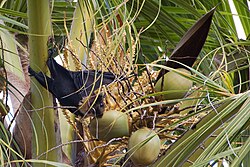Coconut palm
The coconut is a palm tree in the family Arecaceae (palm family). It is a large palm, growing to 30 m tall. It has leaves that are 4–6 m long. The term coconut refers to the fruit of the coconut palm.
| Coconut | |
|---|---|

| |
| Coconut palm (Cocos nucifera) | |
| Scientific classification | |
| Kingdom: | |
| Division: | |
| Class: | |
| Order: | |
| Family: | |
| Genus: | Cocos
|
| Binomial name | |
| Cocos nucifera | |

There are many coconut palms on the coasts of Indonesia, India, America, Bangladesh and Tanzania. People of this area use coconut milk in cooking. Women use coconut oil as oil for their hair. The coconut's shell is relatively hard, but can be broken. Because its shell is hard, it can be used as an ingredient to make craftworks.
Coconut milk is also used in many drinks. Coconut oil is often in food and soaps. People in Sri Lanka use coconut flowers for wedding celebrations. In the Maldives it is the National tree.
The coconut is not actually a nut, but is in fact a drupe. Coconuts grow in tropical countries. The flesh of a coconut is white and can be eaten raw or used in cooking. It is used in many of the foods we eat for flavour. It is native to tropical areas.
Seed dispersal
Coconuts float on water and can float to another island and germinate there. It has often been noted that coconuts can travel up to 110 days, or 3000 miles, by sea and are still able to germinate.
+{{{1}}}−{{{2}}}
Coconut Palm Media
Fossil Cocos zeylandica from the Miocene of New Zealand, approximately the size of a strawberry at 3.5 cm (1+1⁄2 in) long
A wa'a kaulua (double-hulled canoe) from Hawai'i. Catamarans were one of the early technological innovations of Austronesian peoples that allowed them to colonize the islands of the Indo-Pacific and introduce coconuts and other canoe plants along their migration routes.
Coconut germinating on Punaluʻu Beach on the island of Hawaiʻi
The Pacific flying fox (Pteropus tonganus) feeding on nectar and pollen from coconut flowers in Fiji










